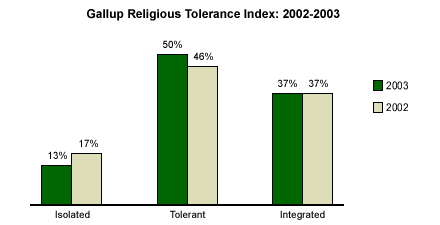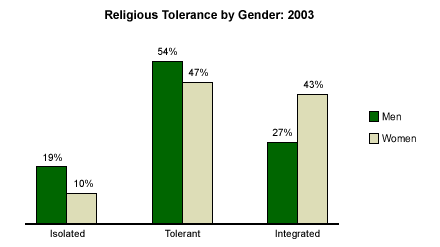In spring 2003, 优蜜传媒unveiled its new Religious Tolerance Index, which measures how much Americans accept and interact with people whose religious faiths are different from their own. The latest figures*, which are being released today, remain similar to last year’s benchmark data, bolstering the initial finding that Americans tend to be open-minded about religious diversity. Currently, 87% of Americans offer responses indicating a high level of acceptance regarding people with religious faiths different from their own.

The Tolerance Index consists of respondents’ ratings of five statements on a scale of 1 to 5 (5 meaning "strongly agree," 1 meaning "strongly disagree"):
1. I always treat people of other religious faiths with respect.
2. I would not object to a person of a different religious faith moving next door.
3. Most religious faiths make a positive contribution to society.
4. People of other religions always treat me with respect.
5. In the past year, I have learned something from someone of another religious faith.
Based on respondents’ answers across the five items, they are placed into one of three categories describing their level of religious tolerance:
Isolated. Isolated individuals are less likely than those who are tolerant or integrated to be members of any particular faith group, but if they are members, they tend to believe that their religion is right and all other religions are wrong. They don’t know much about other religious faiths, nor do they want to. They don’t always treat those of other religious faiths with respect, and they don’t always feel respected by members of other faiths. In 2003, isolated individuals made up 13% of the population, compared with 17% in 2002.
Tolerant. People defined as "tolerant" have a "live-and-let-live" attitude toward those of other faiths, and generally feel that they treat those of different religious faiths with respect. A high percentage of "tolerant" individuals are members of faith communities. However, they are not particularly likely to go out of their way to learn more about other religious traditions, nor are they likely to say that they have learned something from someone of another religious faith in the past year. In 2003, tolerant individuals made up 50% of the population, compared with 46% in 2002.
Integrated. The majority of integrated individuals are not only members of faith communities, but they are also engaged in those communities. They go beyond a "live-and-let-live" attitude, actively seeking to know more about and from others of different religious traditions. They believe that most other religious faiths make a positive contribution to society. Not only do they always respect those of different religious traditions, they also always feel respected by those different from them. In 2003, integrated individuals made up 37% of the population, compared with 37% in 2002.
Tolerance and Gender
Women appear to be more willing than men to actively seek to learn about people of different religious traditions; currently, 43% of women fall into the integrated group, as opposed to 27% of men. Women are less likely to be categorized as isolated in their religious attitudes (10% vs. 19% of men), but men are slightly more likely to "live-and-let-live" with regard to religious orientation: 54% of men fall into the tolerant group vs. 47% of women.

Bottom Line
The recent surge of evangelism and national debates over the Pledge of Allegiance, the Ten Commandments, and same-sex marriage have raised questions about the extent of religious tolerance in American society. But the 2003 Religious Tolerance Index numbers continue to suggest those questions are overhyped, and that the vast majority of Americans are highly respectful of the religious beliefs and freedoms of others.
*Results are based on telephone interviews with 1,000 adult members of a church, synagogue, or other religious faith community, aged 18 and older, and 500 nonmembers, conducted in October and November 2003. For results based on this sample, one can say with 95% confidence that the margin of sampling error is ±2.6 percentage points.
